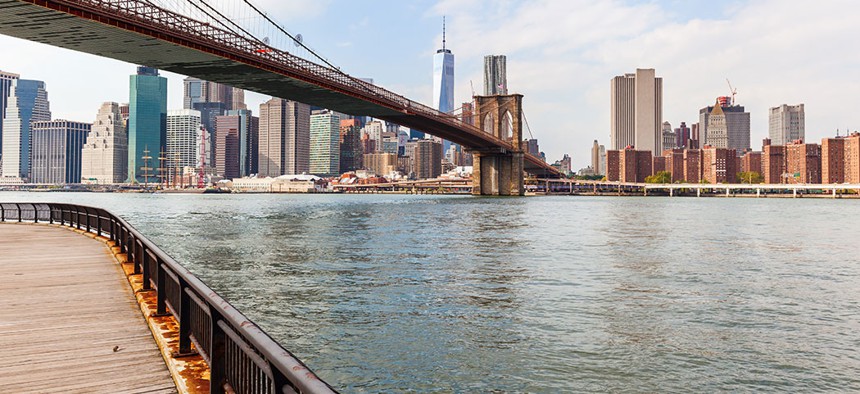A massive new Williamsburg waterfront development proposal was unveiled on Thursday, and it includes two sky-high towers, a six-acre park, a YMCA and – most intriguing – a sandy beach.
The project developed by Two Trees Management – the firm responsible for the Domino Sugar Factory project – would extend into the East River and have public tidal pools, a fishing pier, salt marsh and kayak rentals to compliment its man-made beach.
Since news of this lofty plan was revealed, some have scoffed at the thought of taking a dip in the East River. “If the DUMBO developer gets its way, what was once a No. 6 fuel oil storage complex could soon become the No. 1 beach destination for bacteria-resistant New Yorkers,” wrote Gothamist.
Indeed, the East River hasn’t always been the pinnacle of cleanliness – its waters were once referred to as the “syringe tide” after medical waste made its way across the city’s shoreline in 1988. But the city’s waterways have made significant strides since then.
Although the East River is far cleaner than one might suspect, there’s a lot to keep in mind before you dive into its waters. Plus, it’s technically illegal to enter the East River, even though it’s not illegal to swim in it – but that’s a confusing legal riddle to wade into another time.
Here’s what you need to know about swimming in the city’s most notorious waterway:
Yes, it’s okay to swim in the East River – but there are a few caveats
“Is the East River safe to swim in? Yes, sometimes,” Mike Dulong, senior attorney for the New York water quality advocacy group Riverkeeper, told City & State over the phone.
Dulong explained that during heavy rainfall, rainwater will run off the city’s streets and industrial properties, along with raw sewage, which then gets discharged into the city’s waterways. About 21 billion gallons of this combined sewage end up in the city’s waterways annually – and this sewage cocktail ends up getting dumped into the East River about 70 times a year.
The sewage that finds its way into the rivers during heavy rainfall also releases a bacteria known as enterococci. The bacteria is commonly found in sewage and is responsible for causing numerous infections in humans and other animals. But as long as enterococci levels are below 35-colony forming units, the water is considered safe for people to enter, Inverse reported.
Riverkeeper compiles an ample amount of data regarding the water quality of New York’s waterways, tracking enterococci levels before and after rainfall. Riverkeeper also provides beach advisories, so you never have to wonder when it’s safe to swim. It’s also better to swim in waterways with greater tidal flushing – where water flows quickly – like the East River, where enterococci as well as other forms of bacteria are unable to stick around for long.
But Dulong explains that the area where the new waterfront development would be doesn’t have as strong of a tidal flush as the rest of the East River. “If you go way up into the tributaries around Dutch Kills, Williamsburg and Greenpoint, about two miles back, the water really doesn’t flush out that much,” Dulong said. “So, some of that sewage just kind of sits and takes a long time to clear out of that waterway.”
In order to prevent a buildup of bacteria and ensure that this new beach would be clean enough for swimmers, Dulong said that rainfall in the area would need to be vigilantly captured and treated.
In general, though, it’s not the bacteria or cleanliness of the East River people should worry about it’s the river’s strong currents. “Generally, we say it’s dangerous because the tide is so strong and the currents are so strong,” Dulong said, “but I understand that this (new development) is designed with some sort of barrier to take that danger away and to take the danger of boats away.”
The city’s water is cleaner than it’s ever been
If you’re still hung up on the fact that the East River is at times full of sewage, consider the fact that the city’s waterways are cleaner than they’ve been in years. Throughout the past decade, over $12 billion has been invested into upgrading the city’s wastewater treatment plants and improving the water quality of its harbors. In 2017, New York City Mayor Bill de Blasio announced that the city’s harbors are “cleaner and healthier than it had been in more than a century,” thanks to numerous upgrades to its wastewater system, with concentrations of bacteria in serious decline. Even back in 2013, The Verge reported that the level of bacteria in the East River meets federal guidelines on most days, and even on the days that it doesn't it's still unlikely to make people sick.
Still, Dulong questioned whether it’s sensible to build along the city’s shoreline when the city will likely have to contend with rising sea levels due to climate change in the near future.
“It's concerning, both in terms of harming the water, but also we do want a resilient shoreland in New York City,” he said. “So building on the shoreline, I don’t know if that's a good idea or not.”
Correction: This article originally stated that 1.1 billion gallons of this combined sewage end up in the city’s waterways annually instead of 21 billion gallons of combined sewage.


